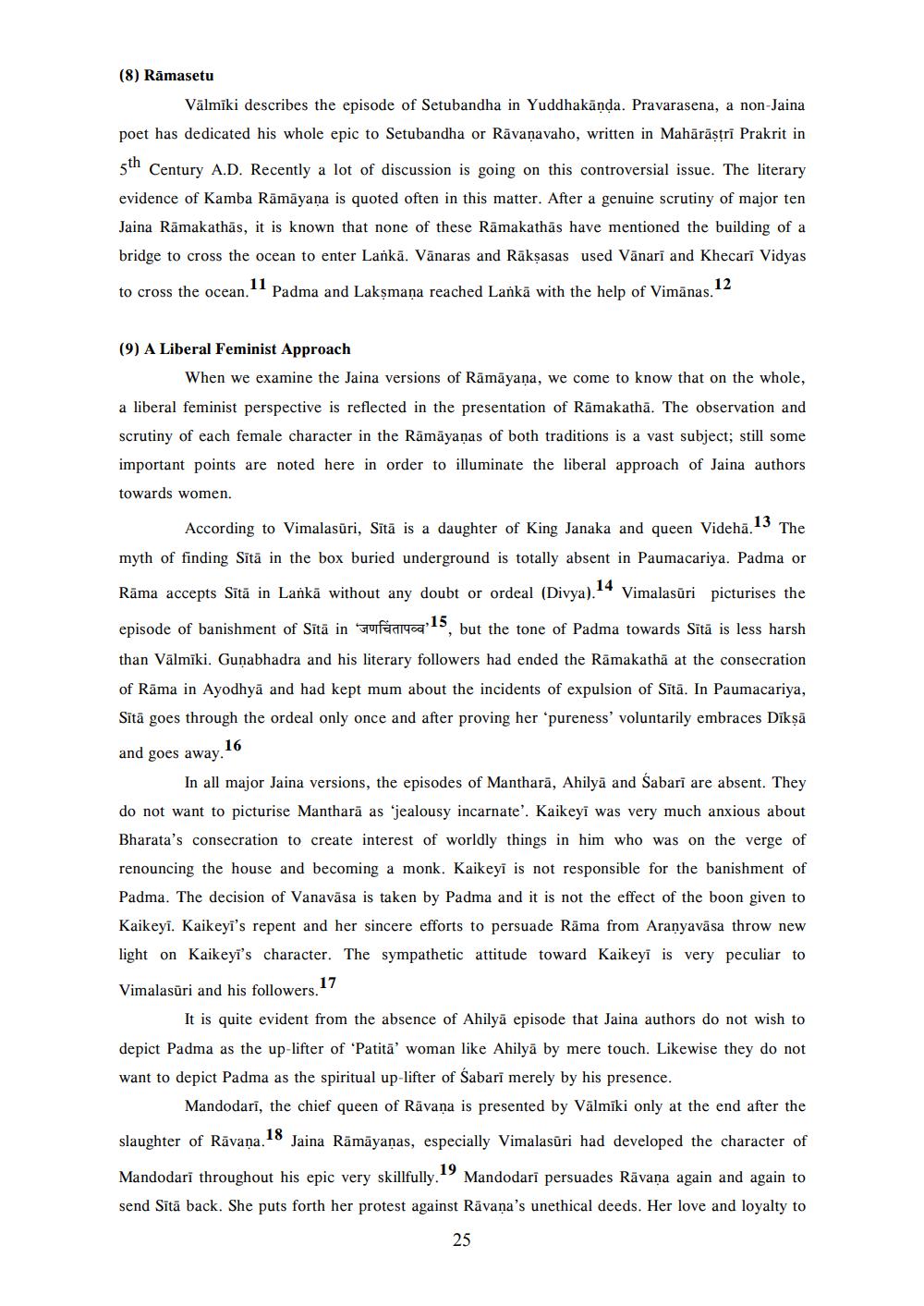________________
(8) Rāmasetu
Vālmīki describes the episode of Setubandha in Yuddhakānda. Pravarasena, a non-Jaina poet has dedicated his whole epic to Setubandha or Rāvanavaho, written in Mahārāştri Prakrit in
5" Century A.D. Recently a lot of discussion is going on this controversial issue. The literary evidence of Kamba Rāmāyana is quoted often in this matter. After a genuine scrutiny of major ten Jaina Rāmakathās, it is known that none of these Rāmakathās have mentioned the building of a bridge to cross the ocean to enter Lankā. Vānaras and Rākşasas used Vānarī and Khecari Vidyas
to cross the ocean." Padma and Lakṣmaṇa reached Lankā with the help of Vimānas.12
(9) A Liberal Feminist Approach
When we examine the Jaina versions of Rāmāyana, we come to know that on the whole, a liberal feminist perspective is reflected in the presentation of Rāmakathā. The observation and scrutiny of each female character in the Rāmāyaṇas of both traditions is a vast subject; still some important points are noted here in order to illuminate the liberal approach of Jaina authors towards women.
According to Vimalasuri, Sitā is a daughter of King Janaka and queen Videha. 3 The myth of finding Sītā in the box buried underground is totally absent in Paumacariya. Padma or
Rāma accepts Sītā in Lankā without any doubt or ordeal (Divya).'4 Vimalasūri picturises the
episode of banishment of Sītā in suflyod , but the tone of Padma towards Sītā is less harsh than Vālmīki. Gunabhadra and his literary followers had ended the Rāmakathā at the consecration of Rāma in Ayodhyā and had kept mum about the incidents of expulsion of Sītā. In Paumacariya, Sītā goes through the ordeal only once and after proving her pureness' voluntarily embraces Diksā and goes away. 16
In all major Jaina versions, the episodes of Mantharā, Ahilyā and Sabari are absent. They do not want to picturise Mantharā as 'jealousy incarnate'. Kaikeyi was very much anxious about Bharata's consecration to create interest of worldly things in him who was on the verge of renouncing the house and becoming a monk. Kaikeyi is not responsible for the banishment of Padma. The decision of Vanavāsa is taken by Padma and it is not the effect of the boon given to Kaikeyi. Kaikeyi's repent and her sincere efforts to persuade Rāma from Aranyavāsa throw new light on Kaikeyi's character. The sympathetic attitude toward Kaikeyi is very peculiar to Vimalasuri and his followers. 17
It is quite evident from the absence of Ahilyā episode that Jaina authors do not wish to depict Padma as the up-lifter of 'Patitā' woman like Ahilyā by mere touch. Likewise they do not want to depict Padma as the spiritual up-lifter of Sabarī merely by his presence.
Mandodarī, the chief queen of Rāvana is presented by Vālmīki only at the end after the
slaughter of Rāvana.
Jaina Rāmāyaṇas, especially Vimalasūri had developed the character of
Mandodari throughout his epic very skillfully." Mandodari persuades Rāvana again and again to send Sītā back. She puts forth her protest against Rāvana's unethical deeds. Her love and loyalty to
25




